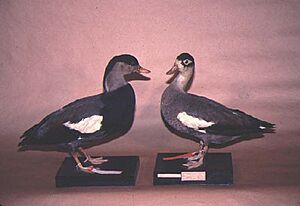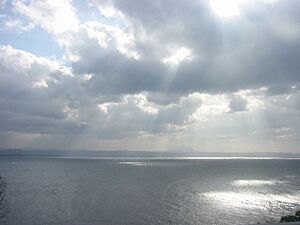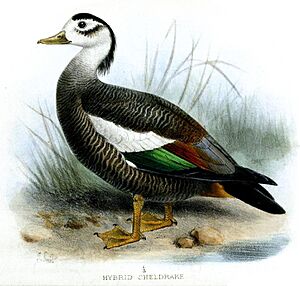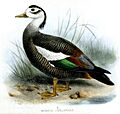Crested shelduck facts for kids
Quick facts for kids Crested shelduck |
|
|---|---|
 |
|
| Male (left) and female specimens, Kuroda collection, Tokyo, Japan | |
| Conservation status | |
| Scientific classification | |
| Genus: |
Tadorna
|
| Species: |
cristata
|
 |
|
| Area from which the crested shelduck is known; current range unknown | |
| Synonyms | |
|
|
The crested shelduck (Tadorna cristata) is a very rare bird from the duck family, Anatidae. It is also called the Korean crested shelduck. This bird is considered critically endangered, which means it's at a very high risk of disappearing forever.
Male crested shelducks have a greenish-black head, chest, and tail. Their face, chin, and throat are brownish-black. Their belly and sides are dark grey with black stripes. The top of their wings are white, and a bright green patch shines on their wing. Females have a white ring around their eyes and a black crest. Their face, chin, throat, and neck are white. Their body is dark brown with white stripes. Both males and females have a special green tuft of feathers sticking out from their head.
We don't know much about this bird because it's been seen so rarely. It likely nests in Korea and eastern Russia. Some people think it might be extinct, but there have been a few possible sightings. Because of these reports, it is still listed as critically endangered. However, no one has definitely seen a crested shelduck since 1964.
Contents
What is the Crested Shelduck?
The crested shelduck is a type of waterfowl. It belongs to the same family as ducks, geese, and swans. This bird is known for its unique look. It has a special crest of feathers on its head.
How Was the Crested Shelduck Discovered?
The first crested shelduck was found in April 1877 near Vladivostok, Russia. But it wasn't officially described until 1890. A zoologist named Philip Sclater thought it might be a mix of two other ducks. He believed it was a hybrid of the ruddy shelduck and the falcated duck.
Around 1913, a pair of these birds was found in Korea. The male was given to a Japanese bird expert, Nagamichi Kuroda. Kuroda noticed that the bird's feathers didn't look like a mix of the two ducks Sclater suggested. In 1917, Kuroda officially described this bird as a new species. He named it Pseudotadorna cristata. Later, it was placed in the genus Tadorna, which includes other shelducks.
What Do Their Names Mean?
The name Tadorna comes from an old Celtic word. It means "pied waterfowl," which is like saying "colorful duck." The word cristata comes from Latin. It means "crested," referring to the feathers on its head. The common name "crested shelduck" also comes from this green feather tuft. People sometimes call it the Korean crested shelduck.
What Does the Crested Shelduck Look Like?
The crested shelduck has different looks for males and females. This is called sexual dimorphism.
Male Crested Shelduck Appearance
Males have a greenish-black head, chest, and tail. Their face, chin, and throat are brownish-black. Their belly and sides are dark grey with black stripes. The top parts of their wings are white. They have a shiny, iridescent green patch on their wings. The male's bill has a small, knob-like bump at its base.
Female Crested Shelduck Appearance
Females have a large white ring around their eyes. They have a black crest on their head. Their face, chin, throat, and neck are white. Their body is dark brown with white stripes.
Both male and female crested shelducks have a green tuft of feathers on their head. Their bills and legs are pinkish. The female's colors are usually lighter than the male's. This bird is about 63 to 71 centimeters (25 to 28 inches) long. This makes it a bit bigger than a common mallard duck. We don't know what young crested shelducks look like.
Where Does the Crested Shelduck Live?

Crested shelducks have been found in Vladivostok, Russia. They have also been seen near Busan and Kunsan in Korea. Experts think they might breed in far-eastern Russia, northern North Korea, and northeast China. They might spend winter in southern Japan, southwest Korea, and along the east China coast. This includes areas as far south as Shanghai.
What Kind of Habitat Do They Prefer?
This species is thought to live in many types of wet areas. These include wetlands and deep-water places. They can be found at different heights above sea level. All the birds found so far were near the coast, especially near river mouths. However, there have been recent reports from inland wetlands in northeastern China. Some people think these ducks might nest in mountains. They could live away from water or near volcanic lakes.
What Do We Know About Their Life?
Not much is known about the crested shelduck's daily life. But we believe they are migratory. This means they travel from Siberia during the breeding season. They then fly to Korea, southern Russia, and Japan for the winter.
What Do They Eat?
The crested shelduck is thought to eat many things. This includes water plants and farm crops. They might also eat algae, small creatures without backbones, and shellfish. They could also eat crabs, dead animals, and even garbage. Some think they might feed at night.
How Do They Nest?
We don't know exactly where the crested shelduck builds its nest. But other shelducks often nest in burrows or holes. So, it's possible this species might nest in tree holes. It's thought that the female lays fewer than ten eggs. She probably sits on them by herself. They are believed to breed from May to July. These ducks have been seen in small groups of two to eight birds.
Why is the Crested Shelduck Endangered?
The crested shelduck has never been common in recent times. It was probably more widespread long ago. This is because it was kept by people in Japan. We only know about this bird from a few sightings. Some people even thought it was extinct in 1916. This was after a female was shot in Busan, South Korea.
Recent Sightings and Doubts
In 1943, a sighting was reported in Korea. This gave people hope the species was still alive. In 1964, two Russian students saw three birds near Vladivostok. They were with a small group of harlequin ducks. There were also reports from North Korea in 1971 and eastern Russia in 1985. However, there are doubts about the 1971 report. A recent survey of hunters in China led to many unconfirmed reports. For example, a Chinese forest worker said he accidentally ate two in 1984. There are also unconfirmed reports of about twenty crested shelducks in China. But many think these might be other ducks, like ruddy shelducks. If the species still exists, there are likely fewer than 50 birds left.
Threats to Their Survival
This species is in danger of extinction. This is due to losing their homes (habitat loss). Hunting and collecting too many birds also threaten them. In 1983, 300,000 leaflets were given out. These were in Russia, Japan, China, South Korea, and North Korea. The goal was to find reports of the birds and stop hunters. But only the 1971 North Korea report came from this effort. More leaflets were given out in China in 1985 and 1991. This led to 82 reports, but follow-up searches found no ducks. A big building project, the Tumangan Development Project, also threatens their possible habitat.
How Humans Have Interacted with This Duck
This duck was brought from Korea to Japan between 1716 and 1736. People kept them as pets. They were known as the Korean Mandarin Duck. They were captured for pet keeping in Japan until at least 1854. The duck was even shown in a Japanese book about keeping birds. Old Chinese tapestries also show a duck that looks like the crested shelduck.
Museum Specimens
Only three specimens of this duck exist in museums today. The only male specimen is kept with a female in Japan. They are at the Yamashina Institute for Ornithology in Tokyo. The male was found in 1913 or 1914. The female was found in December 1916. Another female specimen was found in Russia in 1877. It is now kept in the National Museum of Denmark in Copenhagen.
Two other crested shelduck specimens are known to have existed. But both have been lost. One female, found in 1913, was given to a friend and disappeared. Around 1900, a Chinese hunter offered a specimen to a professor. But the professor didn't know how rare the bird was and turned it down. In 1991, the crested shelduck even appeared on a Mongolian postage stamp.
Images for kids
-
Sea of Japan, where most reports of the crested shelduck come from







